The new year has arrived, and good intentions abound. Instead of setting improbable goals for yourself that fade after a month or two, consider making a resolution for the birds. One simple commitment can help support our winter songbirds and improve your record of fulfilling new year’s resolutions. Throughout the year, but especially during the winter months, you will want to spend some quality time cleaning your bird feeders and bird baths on a regular basis.
Last winter, those of us in the wildlife community received many reports of sick and dead birds, specifically wild Pine Siskins. The tiny, heavily striped, yellow-accented finches are a common visitor to bird feeders. A shortage of food in their northern home range last year, meant that many more Pine Siskins moved south, crowding bird feeders. Although reports of salmonellosis occur yearly during the winter, last year’s ecological conditions in Pine Siskin habitat may have contributed to the substantial outbreak.
At the same time, from January through April 2021, the CDC and public health officials documented a multistate outbreak of Salmonella Typhimurium infections in people. The affected area included Oregon, Washington, and California, and nine other states, and 29 people were reported sick, some requiring hospitalization. The common denominator in almost all these cases – wild birds. People reported owning a bird feeder, having contact with a sick or dead bird, or having a pet that had access to or contact with wild birds.
Birds can transmit salmonellosis, the disease caused by bacteria belonging to the genus Salmonella, to humans and to other birds by fecal contamination of food and water and even by bird-to-bird contact. Bird feeders and bird baths, and the areas surrounding them, can become a vector of the disease. This is more of concern in the winter as resources are scarce and birds rely on feeders more. Many of us place bird feeders outside our homes with a goal of supporting wildlife and bird feeder hygiene is an important responsibility we assume. Removing bird feeders completely from the landscape may sometimes be warranted in cases of outbreaks and the best way to support birds.
If you host birds at feeders and bird baths, there are plenty of things you can do to ensure healthful conditions for the birds and yourself. Bird feeders should be cleaned on a regular basis throughout the year. Monthly cleanings are generally sufficient, but during the winter, we recommend cleaning your bird feeder or bath on a weekly basis. Disinfect feeders by soaking or dousing them with a bleach solution (one part bleach to nine parts water) for about ten minutes. Then scrub feeders, inside and out, with warm soapy water. Make sure to thoroughly rinse the feeders and then allow them to dry completely before refilling and setting them back out. Make sure you sanitize the area where you cleaned your feeder. We recommend avoiding your kitchen sink and cleaning your feeder outside or in a bathtub. Salmonellosis can also be transmitted to ground dwelling birds who gather under your feeder. On a weekly basis you will also want to rake up and discard seed and debris under your feeders. To protect yourself, make sure to wash your hands thoroughly after touching or cleaning your feeders and keep your pets away from feeder areas.
During the next few months keep an eye out for birds, especially Pine Siskins, that may appear lethargic, puffed up, or with swollen, irritated, or partially closed eyes. If you see these signs or suspect that a bird may be sick contact SNCO, another wildlife rehabilitation center, or Oregon Department of Fish & Wildlife. If you find a dead bird in your area, wear gloves to collect the bird and double bag it before bringing it to a wildlife rehabilitator.
Photo: Tom Lawler

